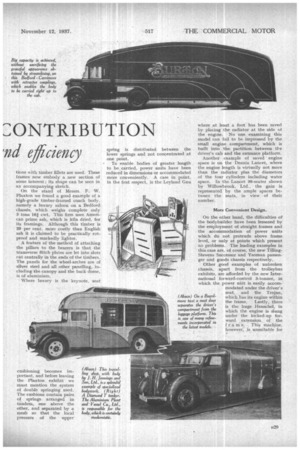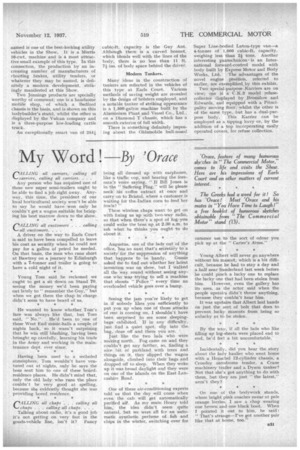BODYBUILDERS :ONTRIBUTION to safet
Page 12

Page 13

Page 14

Page 15

If you've noticed an error in this article please click here to report it so we can fix it.
Fned eficieng OPINIONS differ strongly in respect of the use of metal or wood for passenger-vehicle body frames'. Whilst some • hold that the tendency is towards the elimj,itation of timber altogether, others maintain that, for high-class frame construction, the employment of metal should be confined to flitch plates, bolts, screws and such-like small parts.
One may divide passenger-body construction into three main classes— strictly all-metal, composite and timber. There are, in addition, intermediate types ranging from the midway category to one extreme or the other. Again, general distinctions may be drawn between luxury coaches for excursions and tours, semi-luxury machines for long-distance express work, and buses for stage service.
Higher Efficiency—Heavy Stresses.
• Great strength becomes more and more necessary for safety and freedom from trouble. Brakes of high efficiency impose severe stresses an the framework; as also does rapid acceleration. Few oil engines are without a period of vibration and even when elastic suspension is employed for the power unit this vibration, usually most prevalent at tick-over speeds, is often reflected in more frequent body troubles.
• There seems little doubt that for sheer strength the all-metal or composite body is superior to that built mainly of timber, and we have actually beard of a case in which a coach, which had been involved in a serious accident, had suffered more damage to the chassis than to the metal body.
In this connection it is of deep interest to learn that Weymann'S Motor Bodies (1925), Ltd., has constructed a vehicle in which the chassis frame and body frame are one; a model is ,on the company's stand. There is every likelihood that a machine of this design will become a standard product.
Strictly AEI-metal.
Perhaps the only body in the Exhibition which has no wood at all in its make-up is that displayed by Grose, Ltd. It is of American origin and incorporates Z sections; (this description is really misleading because the angles are of 90 degrees).
A big advantage of this pillar shape is that, whilst the inside panelling is secured by screws into the appropriate faces, the edges of the outer panels are bent and held by longitudinal bolts to the transverse faces. Thus they are easily detachable from the inside and require no moulding over the joints, affording, in consequence, a smooth exterior.
We spent some time at Earls Court examining the bodywork of the Brush Electrical Engineering Co., Ltd., in which metal sec tions with timber fillets are used. These frames now embody a new section of some interest ; its shape can be seen in an accompanying sketch.
On the stand of Messrs. F. W. PIaxton we found a good example of a high-grade timber-framed coach body, namely a luxury saloon on a Bedford chassis, which weighs complete only 3 tons I6f cwt. This firm uses American prime ash, which is kiln dried, for its framings. Although this timber is 20 per cent, more costly than English ash it is claimed to be practically rotproof and markedly lighter.
A feature of the method of attaching the pillars to the bearers is that the transverse flitch plates are let into slots cut centrally in the ends of the timbers. The panels for the wheel-arches are of silver steel and all other panelling, including the canopy and the back dome, is of aluminium.
Where luxury is the keynote, seat cushioning becomes important, and before leaving the PLaxton exhibit we must mention the system of double springing used. The cushions contain pairs of springs arranged in tandem, one above the other, and separated by a mesh so that the local pressure of the upper
where at least a foot has been saved by placing the radiator at the side of the engine. No one examining this model can fail to be impressed by the small engine compartment, which is built into the partition between the driver's cab and the entrance platform.
Another example of saved engine space is on the Dennis Lancet, where the engine length is virtually not more than the radiator plus the diameters of the four cylinders including water space. In the Lancet 39-seater shown by Willowbrook, Ltd., the gain is represented by the ample spaces between the seats, in view of their number.
More Convenient Design.
On the other band, the difficulties of the bodybuilder have been lessened by the employment of straight frames and the accommodation of power units which do not protrude above frame level, or only at points which present no problems. The leading examples in this case are, of course, the new TillingStevens Successor and Yeoman passenger and goods chassis respectively.
Other good examples of unbroken chassis, apart from the trolleybus exhibits, are afforded by the new International forward-control 3-tonner, in which the power unit is easily accommodated under the driver's seat, and the Trojan, which has its engine within the frame. Lastly, there is the huge Henschel, in which the engine is slung under the kicked-up forward extension., of the fram e, This machine, however: is unsuitable for . the British market, and is on view at :Earls Court primarily because of the . important international value of the Commercial Motor Show.
One of the finest coaches on view is undoubtedly the Harrington-bodied A.E.C. Regal observation machine. It has an electrically operated sliding roof, Westinghouse power door, Metcalfe heating and Philco radio. Striking features are the dorsal fin at the rear end of the top and the curved roof lights. This machine may truly be described as a sunshine saloon.
• Another A.E.C. we observed—an express-service coach with a Strachans body—exemplifies 'the treatment that may be given to the front of a machine. In this case the inverted triangle motif of the grille is decorative and compels attention. Another excellent instance of frontal treatment is to be seen on a Guy 26-seater displayed by Samuel Holbrook, Ltd.
Central Twin Staircase.
Various methods are adopted of facilitating the entry and egress of passengers, and an excellent instance of a means for quick loading and unloading is afforded by the Daimler 48-seater to be seen on the stand of Chas. H. Roe, Ltd. Here there is a central entrance which gives access to a twin staircase to the upper saloon. Whilst such a design may not be economical of space, it unquestionably minimizes delays.
Although but a minor detail, moulding design is not altogether an inconsiderable point. The observer at Earls Court will find many types in ,use. A novel and decorative section is to be seen on the Burlingham stand.
To examine now the goods vehicle side of the body exhibits, we find at Earls Court two marked types—one is the streamlined machine built for appearance, and the other the utility body where capacity is of first
We will name two instances, the Bedford Carrimore articulated outfit, produced for a Vtiell-known tailoring company, in which the use of the semitrailer maker's retractor coupling permits ample space and, accordingly, gives freedom in adopting a streamline \ design, and a Thornycroft with body by G Scammell and Nephew, Ltd., which has approximately square corners. Here full advantage is taken of every cubic ft. available.
Another case of streamlining at the expense of capacity is in the handsome 800-cubic-ft. 2-ton van exhibited by Garner Motors, Ltd. Its plainer equivalent would have contained 1,000 cubic ft.
With regard to the use of aluminium in goods-vehicle' bodybuilding, the position seems to be that the additional cost of the lighter metal is definitely justified when a question of speed limit arises. If it be merely a matter of keeping a vehicle in a certain taxation class, the bigger outlay is sometimes questionable.
Incidentally, much money can be spent in the lettering on goods vehicles. As much as £50 can be invested in an applied display, particularly when the letters are built up from the sheet, which method is lighter than forming them of metal-faced plywood.
A modern development in van construction is the use, instead of wood or metal panelling, of composition board. This material is inexpensive, light and easy to work, and, although it may not be so well qualified to withstand rough treatment, panels are quite easily replaced.
Weighing unladen under 4 tons, two A.E.C. Monarchs are shown by the Duramin Engineering Co., Ltd. These exemplify the advantages accruing from the use of light alloy for the bodywork of maximum-load fourwheelers ; one is a 7-cubic-yard tipper. It is now recognized that the alloy used is perfectly suitable for such rough work as transporting sand and gravel.
Space forbids our enlarging further on this interesting subject; we will, therefore, confine ourselves now to -enumerating certain vehicles that 'struck us as being of special interest.
On the stand of Spurling Motor Bodies, Ltd., there is a Bedford long-wheelbase 2-ton cattle carrier, on which the cab and bonnet are painted to match the varnished wood body. The T.T.A. concern is showing a big aluminium-hot semi-trailer of the Four-in-Line t5Tpe. which is built to the exact size necessary for the accommodation of L:350 biscuit tins. • External decoration of delivery vans is becoming more popular Ancillary users are growing more aware of the value of this form of publicity, and examples at the Show are numerous, whilst their appeal is unmistakable. Cut-out figures, fixed to the outside panelling, feature on a Bedford 30-cwt. van with Spurling body. It advertises dyeing and cleaning activities. Further excellent examples are shown by Dodge Bros. (Britain), Ltd., Renault, Ltd., Morris Motors, Ltd., Singer Motors, Ltd., and Cunard Commercial Body Building Co. • On the stand of the last
(Left) Puzzle—find the engine on the new Leyland Gnu. (Below) Details of the construction of the latest Brush metal body. November 12, 1937.
named is one of the best-looking utility vehicles in the Show, It is a Morris 10-cwt. machine and is a rimst attractive small example of -this type. In this connection, the production by an increasing number of manufacturers of shooting brakes, utility tenders, or whatever they may be named, is definitely a modern development, strikingly manifested at this Show.
Two Jennings products are specially worthy of comment: one 'is a handsome mobile shop, of which a Bedford chassis is the basis, and is shown on this bodybuilder's stand, whilst the other is displayed by the Vulcan company and is a three-purpose low-loading cattle truck.
An exceptionally smart van of 2541 cubic-ft. capacity is the Guy Ant. Although there is a curved bonnet, which blends well with the lines of the body, there is no less than 11 ft. 7/ ins, of body space behind the driver.
Modern Tankers.
Many ideas in the construction of tankers are reflected in the vehicles of this type at Earls Court. Various methods of saving weight are revealed by the design of bolsters employed, and a notable tanker of striking appearance is a 1,300-gallon 'machine built by the Aluminium Plant and Vessel Co., Ltd., on a Diamond T chassis, which has a smooth exterior of full width.
There is something definitely imposing about the Oldsmobile bull-nosed Super Line-bodied Luton-type van—a 4-tonner of 1,000 cubic-ft. capacity, weighing less than 2f tons. Another interesting pantechnicon' is an International forward-control model with body built by Express Motor and Body Works, Ltd. The advantages of the novel engine position, referred to earlier, are exemplified, by this exhibit.
Two special-purpose Harriers are on view; one is a C.K.3 model refusecollector 'displayed by Brorifilow and Edwards, and equipped with a Principality moving floor, whilst the other is of the same type, but has a dual-purpose body. This Harrier can be employed as a tipping lorry or, by the addition of a top incorporating easily operated covers, for refuse collection.








































